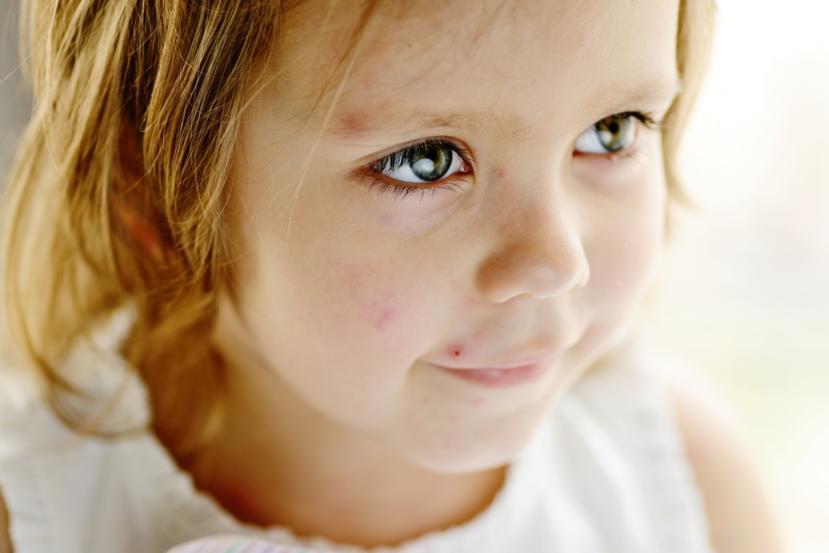Impetigo: Causes, Symptoms, Treatment, and Home Remedies

What is impetigo?
Impetigo is also known as "school sores". It is a common bacterial skin infection that occurs in infants and young children, especially preschoolers. Although it is common among children, adults can get impetigo, too.
The two types of bacteria that can cause impetigo are Streptococcus pyogenes or Staphylococcus aureus. Healthy skin can get infected but the bacteria usually thrives on a damaged or broken skin due to scratches, bites, eczema, and other skin conditions.
Impetigo first develops as a pimple-like blister. When the blister breaks, it oozes out a honey–colored liquid and leaves a “weeping” red patch on the skin. The infection usually resolves on its own within a few weeks. The sores mostly appear on the hands, neck, and face, but it can also occur anywhere on the body.
Typically, it is not very dangerous, but the impetigo rash consists of a cluster of sores, which can end up causing permanent damage to the skin and also cause serious complications if left untreated. People who live in a confined environment commonly develop this type of skin infection. Impetigo is common in Northern Europe, USA, and Canada.
Impetigo is highly contagious and can easily spread by close contact or by sharing contaminated towels, clothes, toys, and other items. Scratching the sores can also help spread the infection to other parts of the body.
Types of impetigo
There are two types of impetigo. The symptoms may vary depending on the type of impetigo. The two types of impetigo are:
1) Non-bullous impetigo (crusted)
It is the most common type of impetigo. Its symptoms include crusty, rapidly bursting sores. It occurs as tiny blisters around the mouth and nose that eventually burst leaving red skin patches that may weep fluid. The area is then covered by a yellowish-brown or tan crust.
2) Bullous impetigo (large blisters)
It is a rare type of impetigo, which affects children below two years old. The blisters usually appear large with a clear yellowish fluid that turns cloudy and dark yellow later on. The area around the blisters usually appears red. The blisters mostly appear on the legs, chest, and arms. They are most likely to stay on the skin for a longer period without bursting.
How does impetigo spread?
The sores formed by the infection are full of bacteria. Touching or scratching the sores can help spread the bacteria to other parts of the body. It also spreads to other people when they use contaminated things such as toys, towels, clothing, or beddings.
The spread can be prevented by practicing good hygiene such as daily bathing and keeping the fingernails short or clean. Children with impetigo should not play with other children until the infection is gone.
What are the causes of impetigo?
It is caused by two different types of bacteria. Staphylococcus aureus produces a toxin, which attacks the protein that keeps the skin cells bounded together. When this protein is damaged, impetigo is spread to the nearby skin areas. Children are easily infected since their immune system is not fully developed.
Bacteria can also invade through broken and damaged skin due to eczema, allergies due to poison ivy, insect bites, cuts, and burns.
When children get colds or allergies, the skin under their nose becomes irritated, which enables the bacteria to invade the body and cause the infection.
The germs can also be passed on through direct contact with an infected person, contaminated objects, or through coughing and sneezing.
Types of impetigo infections
- Primary infection - Impetigo that can affect healthy skin through a cut, bite, or injury.
- Secondary infection - Infection that occurs due to an underlying skin condition such as scabies. Eczema is referred to as secondary impetigo.
Risk factors
1) Age - Impetigo is common among infants and preschool children, but can affect adults as well.
2) Irritated skin - Children with skin allergies and irritation from scratches, insect bites, eczema, and cuts are at a higher risk of impetigo.
3) Compromised immune system - Children who have a poor immune system are also at risk. Poor immune system may be due to chronic diseases, lack of proper nutrition, and illness.
4) Warm climate - A warm or humid climate provides an ideal environment for these germs to grow.
5) Staphylococcus aureus carrier - S. aureus is not always harmful. The bacteria usually exist in the nose of 30 percent of healthy adults. They cause problems when they come in direct contact with damaged skin or with contaminated droplets transferred through coughing or sneezing.
Symptoms of impetigo
The symptoms of impetigo usually appear after 4-5 days from the initial exposure to the bacteria. It means that asymptomatic carriers can pass the infection to others without realizing it.
Non-bullous impetigo symptoms
Approximately 70 percent of impetigo cases are mostly of this type. Symptoms begin with red sores around the mouth and nose. Other facial areas and limbs might also get affected. After a couple of days, the sores burst leaving thick, golden crusts. When the crusts dry, it leaves a red mark but heals without any scar. Healing can take a few days to weeks. The sores are painless but itchy.
Severe cases of impetigo include fever and swollen glands.
Bullous impetigo symptoms
The infection begins with tiny fluid-filled blisters that usually appear on the trunk, arms, or legs. Before bursting, the blisters spread quickly. After several days, the blisters burst and leave a yellow crust. They also heal without any scar. The blisters are painless, but the area around them may appear red and itchy. The symptoms of fever and swollen glands are more common in this type of impetigo.
Diagnosing impetigo
1) Physical examination
Most doctors can diagnose impetigo just by looking at the child’s skin. Doctors may also ask questions related to recent cuts, insect bites, or scrapes to the affected skin areas.
2) Culture
The doctor might collect a sample for culture. It is done by gently wiping the crusted area with a swab. The swab is then sent for laboratory testing to identify which type of bacteria is causing the infection, and to determine which antibiotic may work. The specimen should be collected from the base of the lesion.
Other laboratory tests such as urine and blood tests may be ordered if:
- The symptoms are severe
- There is no treatment response
- The infection recurs
Treatment
1) Antibiotic ointments
If impetigo is mild, the doctor will prescribe a topical antibiotic ointment. In severe cases, the doctor may prescribe antibiotic pills. The doctor may prescribe mupirocin ointment, which is an antibiotic ointment. The scabs should be gently removed before the ointment is applied to enable the antibiotic to penetrate the skin better.
Most sores heal within one week in mild cases. The application of 2 percent mupirocin ointment four times daily has been found to be successful. Use latex gloves when applying the antibiotic ointment. Moreover, hands should be thoroughly washed after its application.
2) Antibiotic pills
Prescribing an oral antibiotic depends on the severity of impetigo, the patient’s medical condition, and whether the patient is suffering from certain allergies. An antibiotic course usually lasts for seven days. For adults, 250 mg of dicloxacillin or cephalexin four times daily can be prescribed.
The side effects of antibiotic pills are stomachache, nausea, diarrhea, yeast infection, or vomiting.
3) Proper hygiene
Once the sores start healing slowly, they can be washed with clean water and soap. The crusts can be gently removed by soaking the affected area in warm water and then patting it dry. This method will work better with ointment or cream. However, there is no need to remove the entire scab.
Home remedies for impetigo
1) Garlic - should be crushed to create a paste. Apply the garlic paste to the affected area to relieve the symptoms of impetigo.
2) Green tea - has anti-inflammatory and antibacterial properties that can accelerate would healing. It contains epigallocatechin gallate (EGCG), which prevents scarring.
3) Tea tree oil - is a natural antiseptic that can help cure impetigo. You can dilute a small amount of tea tree oil into a moisturizing carrier oil or mix a few drops of tea tree oil with argan oil. Apply the oil directly on the affected areas to relieve impetigo.
4) Aloe vera gel – can help speed up the healing process and can fight multidrug-resistant germs. It has been found to be more effective than topical antibacterial medications. The gel should be applied to the affected skin areas five times a day.
5) Colloidal oatmeal bath - is one of the best solutions to itchy skin. It can be purchased but can also be made at home.
6) Diet - eating foods with anti-inflammatory and antibacterial properties can help combat impetigo. Garlic in food helps treat impetigo. Even turmeric prevents the sores from getting worse.
7) Pure Manuka honey - contains vitamins, enzymes, and minerals that can help facilitate a faster healing process. It also kills harmful germs. It can stop the growth of antibiotic-resistant Staphylococcus aureus because it has a low pH and contains hydrogen peroxide.
8) Virgin coconut oil - its fat component moisturizes and softens the crusts, so they become easier to remove. VCO is also regarded as a natural antibiotic.
Prognosis
The prognosis of impetigo is excellent with complete recovery. It takes up to 2-3 weeks of treatment. Usually, scars are rare. Glomerulonephritis is an unusual complication that occurs after infection with certain Streptococcus strains.
Complications related to impetigo
Impetigo also comes with complications, although quite rare.
1) Cellulitis
Cellulitis happens when the infection spreads to the deeper skin layer. Symptoms include redness, inflamed skin, fever, and pain. Antibiotics and paracetamol are usually given for its treatment.
2) Guttate psoriasis
The condition can develop in children after a bacterial infection. It commonly occurs after a throat infection, but there have been cases where it has occurred after impetigo. Guttate psoriasis causes red, drop-shaped, scaly patches. It occurs on the chest, arms, legs, and scalp. Creams can be used to treat the condition.
3) Scarlet fever
Scarlet fever is a contagious bacterial infection caused by Streptococcus pyogenes. It causes pink rashes all over the body. Its most common symptoms are "strawberry tongue", nausea and vomiting, sore throat, and sandpaper-like rash. The condition is treated with antibiotics.
4) Septicemia
It is a form of blood poisoning caused by bacterial toxins. Symptoms include fever, clammy skin, rapid breathing, diarrhea, low blood pressure, confusion, feeling dizzy, and vomiting. Immediate treatment in the hospital is required with antibiotics.
5) Post-streptococcal glomerulonephritis
It is a rare infection of the small blood vessels present in the kidneys. Its symptoms include:
- A change in urine color
- Swollen face, eyes, feet, and abdomen
- Hypertension (high blood pressure)
- Hematuria (blood in urine)
- Decreased urine output
The condition can be fatal in adults. Immediate treatment is required for this condition and requires close monitoring of the patient's blood pressure.
6) Scarring
Scarring occurs as a result of scratching the blisters, crusts, or sores. However, scarring is quite rare. If the blisters and crusts are left to heal by themselves, there will be no scarring. Skin redness also disappears by itself. Skin healing may vary from days to weeks.
Although impetigo resolves on its own, it is still best to consult a doctor for proper diagnosis and treatment.














